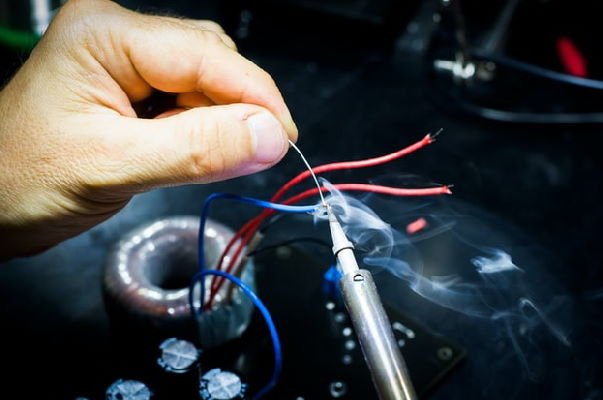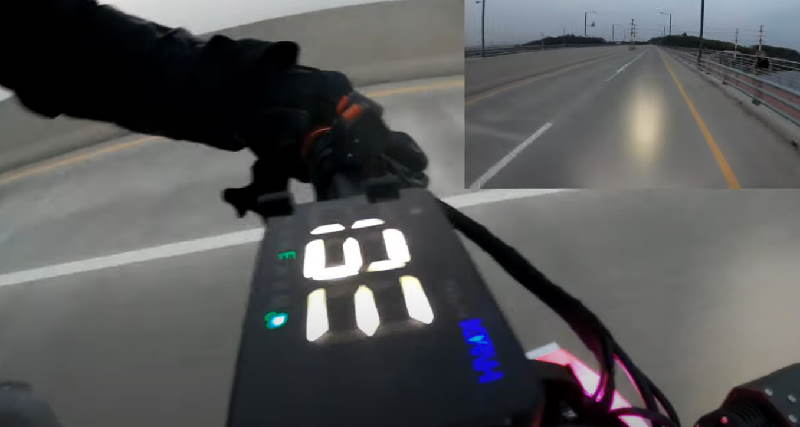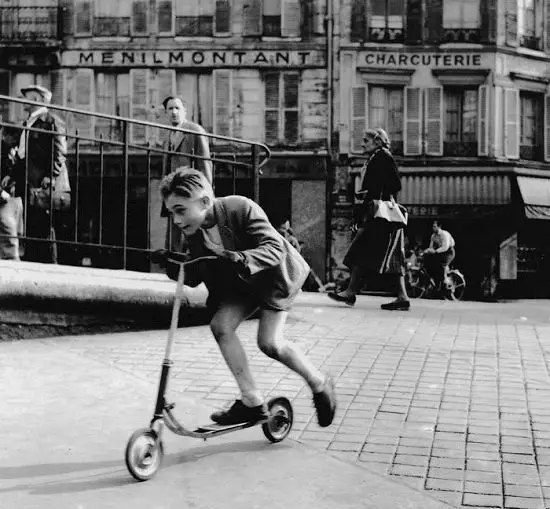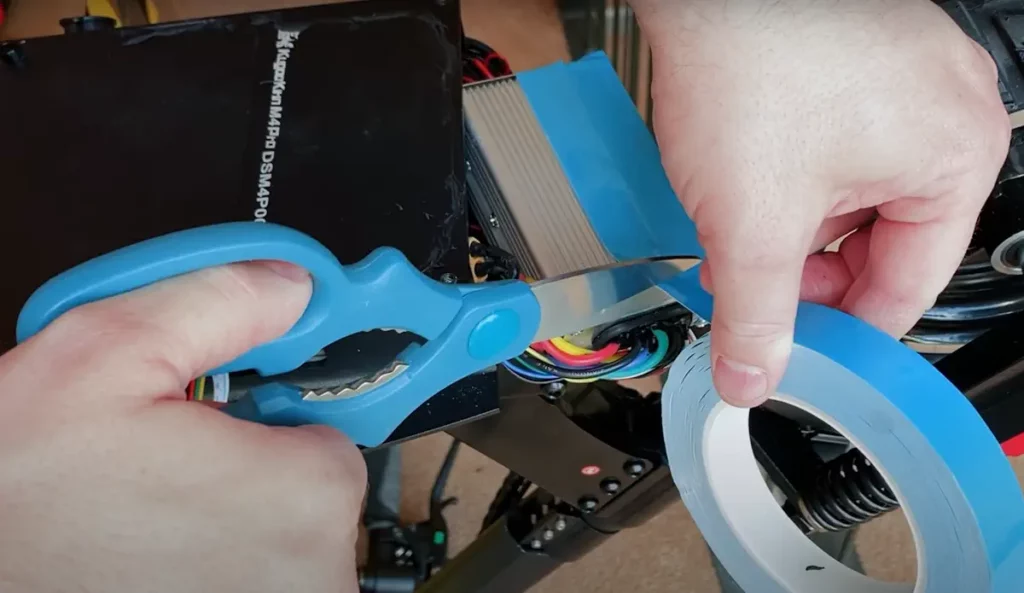Lights are a fairly simple element that most modern scooters have, but still, there are a few things about them you should be aware of if you wish to be a responsible scooter owner.
-
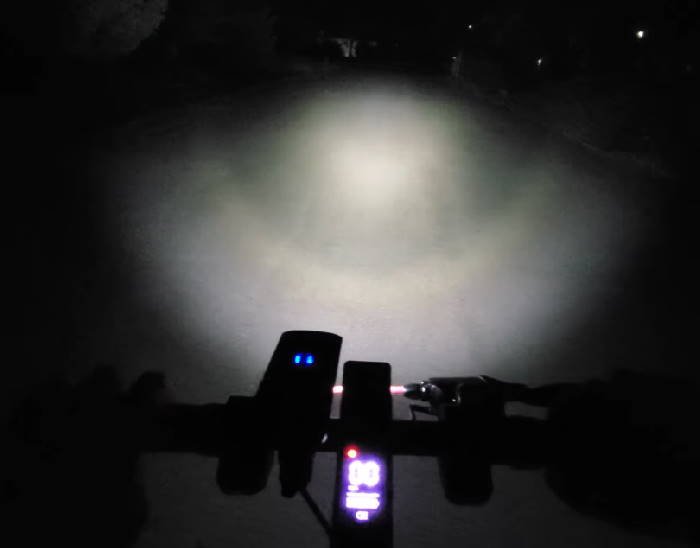 Main headlightsLocation: front stem or handlebarsActivation: automatically or manuallyPurpose: illuminate the path aheadMay have adjustable brightness or modes
Main headlightsLocation: front stem or handlebarsActivation: automatically or manuallyPurpose: illuminate the path aheadMay have adjustable brightness or modes -
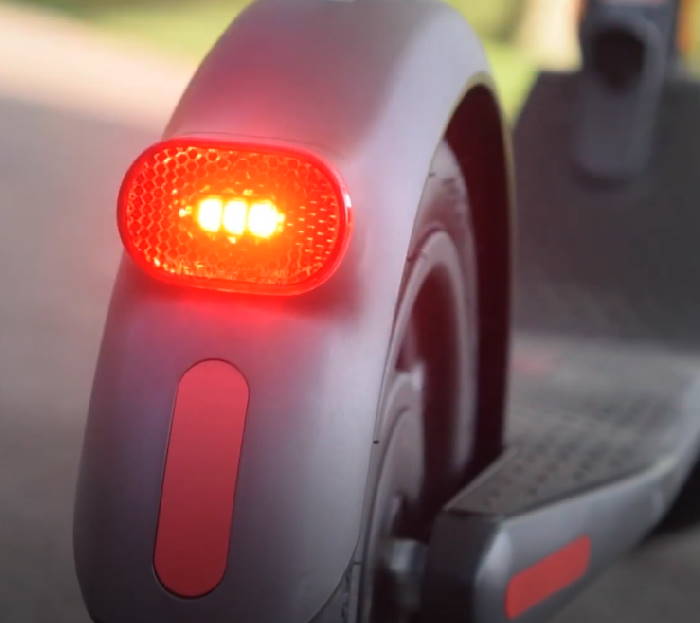 Brake lightsLocation: rear of the scooterActivation: activated by braking actionPurpose: signal to others when you’re slowing downBrightness may vary with braking intensity
Brake lightsLocation: rear of the scooterActivation: activated by braking actionPurpose: signal to others when you’re slowing downBrightness may vary with braking intensity -
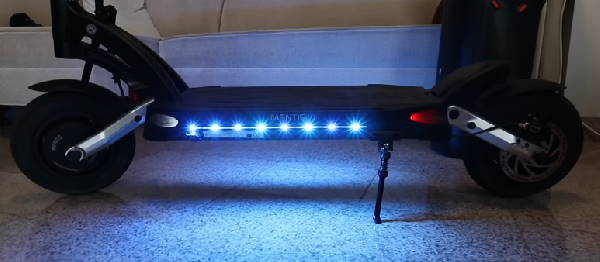 LED stripsLocation: integrated into various parts of the scooterActivation: typically always onPurpose: provide additional visibility and styleMay come in different colors or patterns
LED stripsLocation: integrated into various parts of the scooterActivation: typically always onPurpose: provide additional visibility and styleMay come in different colors or patterns -
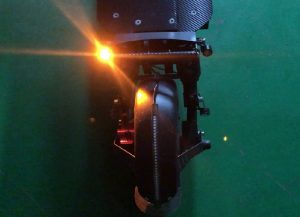 Turn signalsLocation: handlebarsActivation: manually operatedPurpose: indicate the direction you intend to turnMay flash or remain steady during turns
Turn signalsLocation: handlebarsActivation: manually operatedPurpose: indicate the direction you intend to turnMay flash or remain steady during turns -
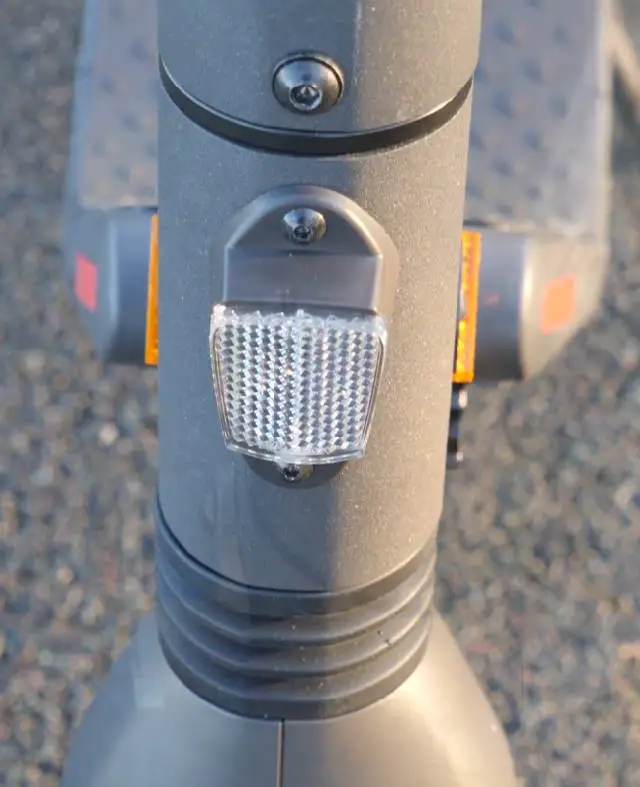 Reflective stickersLocation: found on different parts of the scooterActivation:passive, require external lightPurpose: enhance visibility in low-light conditionsCommonly in white or reflective materials
Reflective stickersLocation: found on different parts of the scooterActivation:passive, require external lightPurpose: enhance visibility in low-light conditionsCommonly in white or reflective materials
Let’s quickly go over the most crucial details about electric scooter lights.
Main headlights

This is the most important type of light in an electric scooter.
Technically, it is the only type of light that you must have to ride at night, or when it’s not too bright but you’re riding at faster speeds (you need some form of rear lighting for safety and legal reasons, but they don’t help you with your riding process per se).
The main headlight or headlights are the most common type of electric scooter light. If a scooter has one type of light, it will be the main headlight. Most scooters with headlights will have one, but some models will have two or even four front lights.
Main headlights may be required for your scooter by traffic laws in many countries.
Most of the main light properties, like the angle, the distance, and the power/intensity, only make sense when talking about the main headlights.
The angle of the light
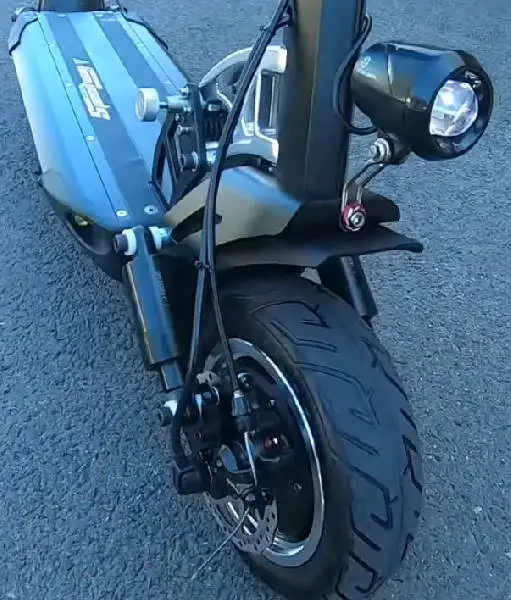
The light angle, specifically for the main headlight, is crucial. It ranges from nearly parallel to the ground to a wider beam focused closer to the scooter.
Adjusting the angle affects distance and brightness.
Narrow angles increase distance but reduce density, while wider angles shine brighter nearby but limit distance.
Power of the light
The power or the intensity of the light describes how strong the light shines.
The scientific term for light power is called the luminous flux, the perceived power of the light source, or the total quantity of visible light emitted by a source per unit of time.
The power of the light is sometimes expressed in Watts, but it’s also often expressed in Lumens as well.
Simply put, Lumens expresses how well the light converts the power it gets (Watts) to visible light. Watts and Lumens are directly related to each other, and the higher the Wattage, the more Lumens the light will produce. Another metric in the equation is the luminous efficacy, expressed in Lumens per Watts, and the formula is as such:
Watts = Lumens / Lumens per Watt
You can learn more about the relationship between Watts and Lumens here.
In general, the higher the Watts or the Lumens of the light, the stronger it will be.
Distance of the light
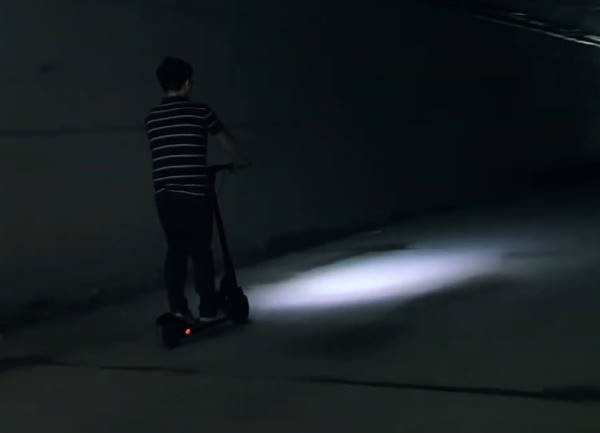
The distance of an electric scooter’s main headlight is determined by its angle and power.
Stronger lights and narrower angles result in longer illumination distances. Other scooter lights are not focused on distance.
Brake lights

Brake lights are almost always red, with the occasional orange light appearing in some models.
Typically, they get activated whenever you use any of the brake systems, and either blink or shine constantly while using the brakes. In many scooters, they can also be turned on permanently.
In many countries, brake lights are required by traffic laws for the scooter to be considered street-legal.
While they are not technically necessary for riding at night, it is very strongly recommended that your scooter has them.
Turn signals
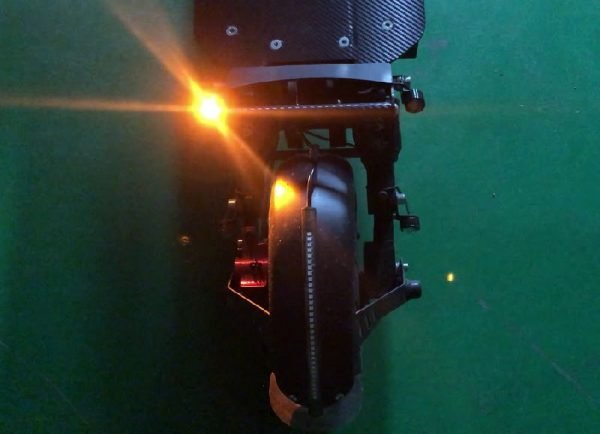
Turn signals are not very common yet, although newer models come with them in increasingly larger numbers.
They are usually orange and are turned on by a button.
In general, turn signals on a scooter are not required by traffic laws, but there are a few countries that do require them.
LED strips

LED strips do a good job of letting other traffic participants know of your position and greatly increase your visibility at night, but they are also a very fun and decorative element for many scooterists.
They can either shine in one particular color or change colors in various rhythms and patterns.
Probably around 30-40% of electric scooters have some form of LED strips. Many scooterists choose to add LED strips to their scoters additionally.
Reflective stickers

They will mostly come in yellow or orange, and sometimes in white.
Reflective stickers on electric scooters are somewhat of a new phenomenon, as very few older models have them.
Some countries require reflective stickers for the scooter to be deemed street-legal, and they are not difficult to add to any scooter, so brands and manufacturers simply started to add them.
The effect of reflective stickers on safety at night is not great, but a scooter should have them rather than not, as they are a very simple component (you can even add them yourself) and there are no downsides to them.
Why do most electric scooters have poor lighting?
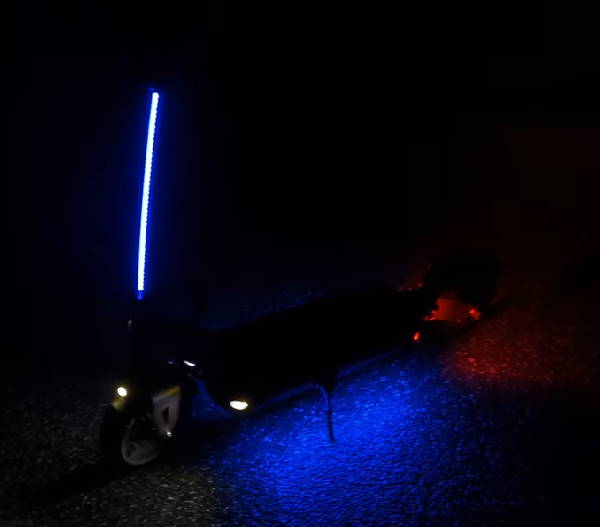
While most electric scooters today come with some form of lighting, very few scooters come with strong lights that are truly strong and won’t need you to replace them if you wish to ride at night.
There are three main reasons for this:
- electric scooters are not meant to be used at night a lot
- electric scooter lights drain the battery quickly
- strong lights in electric scooters are not expected
Most scooter brands clearly warn against riding their scooters at night, even the brands whose scooters have strong lights.
Lights drain the battery quickly, and strong lights drain the battery even quicker.
Most budget scooters today already have mediocre ranges, and adding strong lights to them would make their ranges so small that they might become practically useless.
In some cheaper scooters, the range is almost half of the normal range if riding with the lights turned on! Riding with your lights off is one of the best scooter battery tips and the one over which you have the most control.
Traffic laws for electric scooter lights and night rides

Traffic laws for electric scooter lights and riding at night differ from country to country, and even from state to state or from city to city.
In general, electric scooters need to have both a main headlight and rear brake lights to be considered street legal, and in some countries, even reflective stickers are required as well.
In some countries, riding your electric scooter at night is prohibited altogether, although those countries are rare.
Consult your local authorities and our electric scooter legal guide to find out about your particular location.
Defects of electric scooter lights
Defects in electric scooter lights are relatively common, especially in budget scooters.
If a light in your scooter breaks down, I suggest simply buying another light or set of lights instead of trying to fix the light. The process will be quicker, much simpler, and probably even cheaper in most cases.
The only exception here maybe if the warranty of your scooter is still valid. Even then, you may have to send your scooter to a repair shop, and in some cases possibly cover the shipping costs in both distances.
Still, if your scooter is under warranty, tinkering with it and creating a bigger defect just to fix a relatively small one is not worth the risk.
Case in point: the main headlight for my friend’s Ninebot Max broke down, and he decided to take it to a repair shop. They charged him more than what an extra set of stronger lights would cost initially, and the acceleration of his scooter was never the same after the fix.
Upgrades, customizations, and after-market lights for electric scooters
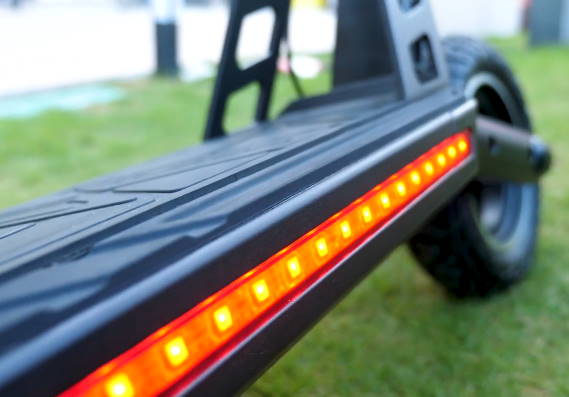
Getting a set of stronger lights is one of the most common upgrades for electric scooters.
Usually, owners buy either a strong main headlight or a set of headlight and brake lights. If you buy brake lights, you will probably have to have them turned on the whole time, as connecting them to the brake systems of your scooter and having them flash when braking would be very difficult.
Also, a lot of owners choose to get LED strips as customization as well.
Typically, even stronger lights are not expensive and are relatively easy to install.
When buying extra lights for your scooter, pay attention to the light power expressed in either Lumens or Watts, but also its connectivity and charging type (usually USB these days) and its water resistance.
Best aftermarket lights for electric scooters
There is a wide array of choices when it comes to upgrades and aftermarket lights for electric scooters, but only a few choices stand out.
The best choice that I usually recommend is the Cincred bike light set, with a main headlight of 400 Lumens and a small red rear brake light. The USB-rechargeable light can shine for more than 8 hours, and it will be pretty strong for most scooterists, while only costing less than $20.
In case you want a truly strong set of lights, then go with the NightRider Lumina 1100. This is another USB-rechargeable set of lights, with 1100 Lumens of intensity, which is almost 3 times stronger than the Cincred budget light.
If you only want a headlight without the rear brake lights, then the NightRider Lumina 850 front light is another excellent choice.
If you only need a rear brake light, then you don’t really need to go overboard as even budget lights are usually well-visible at night, and the BV set of rear bike lights will do just fine, but you can also check out the Cygolite Hypershot 350 Lumens tail light if you want to make sure you are staying as safe as possible.
In case you wish to add an LED strip to your scooter, I really don’t see a need to spend more money than needed, and pretty much any plain old LED strip will do just fine. The Aijiaer LED strip is dirt-cheap and will get the job done, plus you have the option to choose your color.
Finally, if you want to make sure your visibility at night is at the maximum possible level, consider the Gotoone reflective stickers for just a few dollars, or the ECEEN turn signal vest as additional lighting and safety equipment.
Can I add bike lights to my electric scooter?
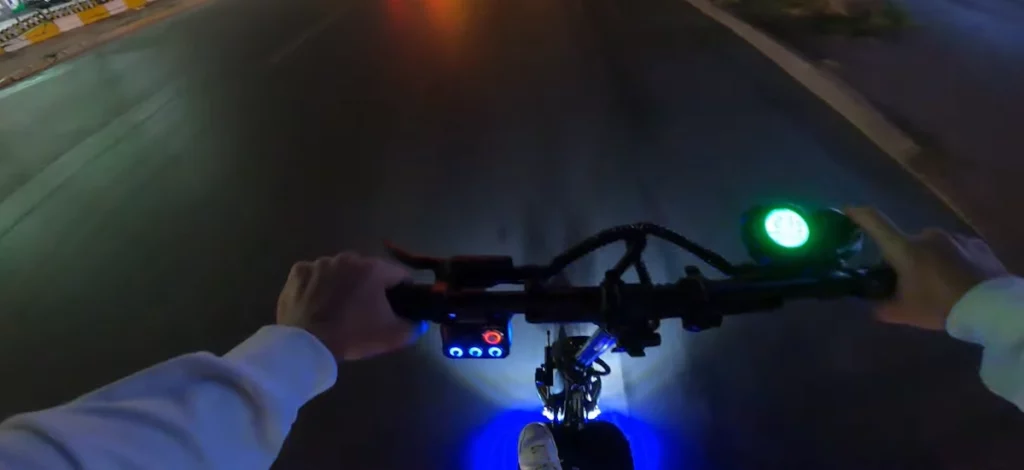
Bike lights are often installed on electric scooters that either have no lighting of their own or have very weak lights. This is a very common scenario, as there are only a handful of light sets that are made especially for electric scooters.
If you want to learn how to install RGB lights on your electric scooter, I recommend checking out Alex’s video.
Electric scooters with the best lights
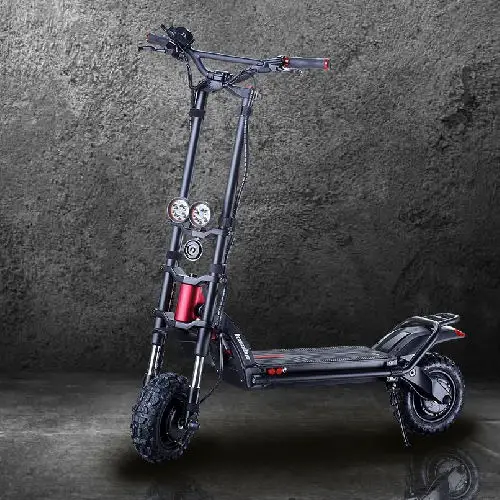
Before we go on to the best-lighted electric scooters, I would recommend simply buying the scooter you want first and then getting stronger lights as an upgrade later.
That said, these are some of the scooters that are of good quality in general and also have decent built-in lights:
- best high-end option: Kaabo Wolf Warrior – very strong headlights (2 main + 2 deck), brake lights, LED strip (read review or buy)
- best mid-price option: EMove Cruiser – strong headlights with 2 deck lights, 3 rear lights, turn signals (read review or buy)
- best semi-budget option: Ninebot Max – decent headlights, rear brake lights, pedestrian mode (read review or buy)
- best budget option: Hiboy Max – as good lighting as budget scooters get, ok headlight + rear light (read review or buy)
Electric scooters with best lights for kids
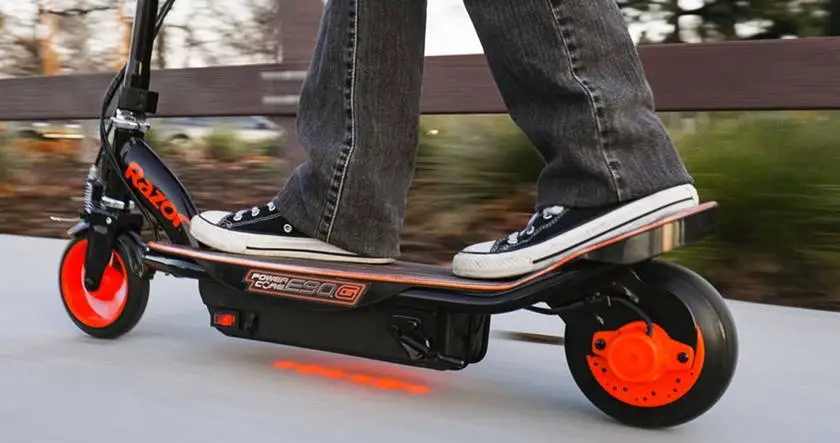
At this point, there are almost no electric scooters for kids with lights that I would recommend. The only exceptions here might be the Razor E100 Glow or the Razor Power Core E90 Glow.
The main problem here is that most of the good scooters for kids have no lights at all, and the scooters for kids with lights are really not good scooters in general. The scooters above come from Razor, which is the best brand of scooters for kids, and they are the only two models that have lighting.
My best recommendation would be to get a Razor scooter for the child depending on the age, and then buy aftermarket lights additionally. Choose some of the following Razor scooters based on the age:
- Razor E100 for ages 8+ (full review here, or buy it here)
- Razor E200 for ages 13+ (full review here, or buy it here)
- Razor E300 for older teenagers (full review here, or buy it here)


